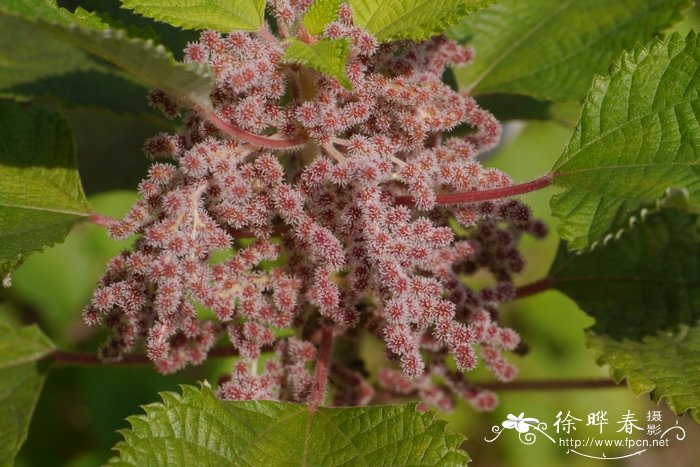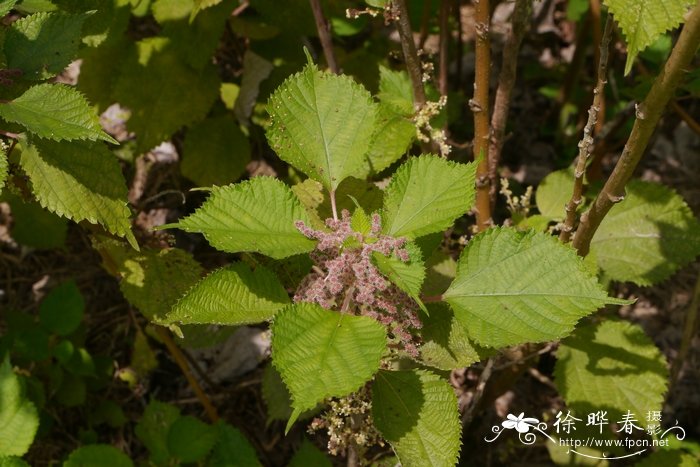苎麻Boehmeria nivea
中文名(Chinese Name):苎麻
学名(Scientific Name):Boehmeria nivea (L.) Hook. f. & Arn.
英文名(English Common Name):
别名(Chinese Common Name):野苎麻
异名(Synonym):Urtica nivea L. Ramium niveum (L.) Small Boehmeria candicans Hassk. Boehmeria frutescens var. viridula (Yamam.) Suzuki Boehmeria juncea Bedevian Boehmeria nivea f. concolor (Makino) Kitam. Boehmeria nivea f. nipononivea (Koidz.) Kitam. Boehmeria nivea subsp. nipononivea (Koidz.) Kitam. Boehmeria utilis André Procris nivea Wedd. Urera lamiifolia Gaudich. Urtica tenacissima Roxb. Urtica utilis de Vriese
科属(Family & Genus):荨麻科Urticaceae苎麻属Boehmeria
形态特征(Description):亚灌木或灌木,高0.5-1.5米;茎上部与叶柄均密被开展的长硬毛和近开展和贴伏 的短糙毛。叶互生;叶片草质,通常圆卵形或宽卵形,少数卵形,长6-15厘米,宽4-11厘米,顶端骤尖,基部近截形或宽楔形,边缘在基部之上有牙齿,上面稍粗糙,疏被 短伏毛,下面密被雪白色毡毛,侧脉约3对;叶柄长2.5-9.5厘米;托叶分生,钻状披 针形,长7-11毫米,背面被毛。圆锥花序腋生,或植株上部的为雌性,其下的为雄性, 或同一植株的全为雌性,长2-9厘米;雄团伞花序直径1-3毫米,有少数雄花;雌团 伞花序直径0.5-2毫米,有多数密集的雌花。雄花:花被片4,狭椭圆形,长约1.5毫 米,合生至中部,顶端急尖,外面有疏柔毛;雄蕊4,长约2毫米,花药长约0.6毫米; 退化雌蕊狭倒卵球形,长约0.7毫米,顶端有短柱头。雌花:花被椭圆形,长0.6-1毫 米,顶端有2-3小齿,外面有短柔毛,果期菱状倒披针形,长0-8-1.2毫米;柱头丝 形,长0.5-0.6毫米。瘦果近球形,长约0.6毫米,光滑,基部突缩成细柄。花期8-10月。
分布(Distribution):产云南、贵州、广西、广东、福建、江西、台湾、浙江、湖北、四川,以及甘肃、陕 西、河南的南部广泛栽培。越南、老挝等地。生于山谷林边或草坡,海拔200-1 700米。
用途(Use):
引自中国植物志英文版:FOC Vol. 5 Page 166
Boehmeria nivea (Linnaeus) Gaudichaud-Beaupré, Voy. Uranie, Bot. 12: 499. 1830.
苎麻 zhu ma | Urticaceae | Boehmeria
Subshrubs or shrubs simple or few branched, 0.5-1.5 m tall; upper stems, branchlets, and petioles densely patent hirsute, appressed strigose or only strigose. Monoecious. Leaves alternate; stipules lanceolate, free or connate and 2-cleft, 7-11 mm; petiole 2.5-10 cm; leaf blade often orbicular or broadly ovate, sometimes ovate or elliptic-ovate, 5-15 × 3.5-13 cm, herbaceous, secondary veins ca. 3 each side of midvein, abaxial surface snowy tomentose, sometimes light green with strigose hairs on veins, or thinly white tomentose, adaxial surface slightly rough and sparsely hispid, base subtruncate, rounded, cordate, or cuneate, margin dentate from base, apex cuspidate or acuminate. Glomerules unisexual, on specialized, unisexual flowering branches in the axils of current or recently fallen leaves, these paired and much branched, usually shorter than petioles and often congested in fruit, male branches proximal or sometimes absent, female distal. Male glomerules few-flowered, 2-4 mm in diam.; female glomerules many-flowered, 2-3 mm in diam. Male flowers 4-merous, sessile; perianth lobes connate to middle, ca. 1.5 mm, pubescent. Female flowers rhomboid-ellipsoidal, 0.6-0.8 mm; stigma ca. 1 mm. Fruiting perianth rhomboid-obovoid, compressed, ca. 1 mm, strigose on shoulder, base constricted and stalklike, apex almost without neck, 2-3-toothed; achenes subovoid, ca. 0.6 mm, base stipitate. Fl. May-Aug, fr. Sep-Nov.
Forest margins, thickets, moist places along streams, roadsides, often cultivated; 200-1700 m. S Anhui, Fujian, Guangdong, Guangxi, Guizhou, Hainan, Hubei, Hunan, Jiangxi, S Shaanxi, Sichuan, Taiwan, Yunnan, Zhejiang [Bhutan, Cambodia, India, Indonesia, Japan, Korea, Laos, Nepal, Sikkim, Thailand, Vietnam].
This species is extremely variable, but can be distinguished easily by its alternate leaves, cymose inflorescences, and stipitate achenes. Two varieties are recognized: var. nivea is known only from cultivation or from naturalized populations; it is a stout plant with dense, long, spreading hairs, free stipules, and broadly ovate to suborbicular leaf blades with the abaxial surface densely, rarely more thinly, white or gray tomentose. Naturalized plants are often smaller with smaller, relatively narrower leaves and shorter inflorescences. Truly wild populations are very variable in stature and indumentum, but can be consistently distinguished by the appressed to assurgent hairs on the stems and leaves and the connate stipules, and are here distinguished as var. tenacissima. The plants are sometimes cultivated. Such plants with concolorous leaves have been variously named as var. concolor, var. tenacissima, var. viridula, and Boehmeria thailandica, but the diagnostic characters seem inconsistent, with many intermediate forms, even within local populations, and so all have been included here within var. tenacissima. More field work and molecular studies are needed to understand more fully this complex species.
Boehmeria nivea is cultivated widely in China, mainly in Jiangxi, but also in S Gansu, S Henan, Hubei, Hunan, S Shaanxi, and Sichuan. The history of the cultivation of this species in China can be traced back at least 3000 years. Ramie, which provides high-quality fiber, is used to make ropes, cloth, and some industrial materials. Ramie was introduced to Europe and North and South America in the early 18th century. Ramie plants are used medicinally to relieve internal fevers and treat infections of the urethra. In addition, young leaves are used as fodder for silkworms.

 ''
''
(责任编辑:徐晔春)
学名(Scientific Name):Boehmeria nivea (L.) Hook. f. & Arn.
英文名(English Common Name):
别名(Chinese Common Name):野苎麻
异名(Synonym):Urtica nivea L. Ramium niveum (L.) Small Boehmeria candicans Hassk. Boehmeria frutescens var. viridula (Yamam.) Suzuki Boehmeria juncea Bedevian Boehmeria nivea f. concolor (Makino) Kitam. Boehmeria nivea f. nipononivea (Koidz.) Kitam. Boehmeria nivea subsp. nipononivea (Koidz.) Kitam. Boehmeria utilis André Procris nivea Wedd. Urera lamiifolia Gaudich. Urtica tenacissima Roxb. Urtica utilis de Vriese
科属(Family & Genus):荨麻科Urticaceae苎麻属Boehmeria
形态特征(Description):亚灌木或灌木,高0.5-1.5米;茎上部与叶柄均密被开展的长硬毛和近开展和贴伏 的短糙毛。叶互生;叶片草质,通常圆卵形或宽卵形,少数卵形,长6-15厘米,宽4-11厘米,顶端骤尖,基部近截形或宽楔形,边缘在基部之上有牙齿,上面稍粗糙,疏被 短伏毛,下面密被雪白色毡毛,侧脉约3对;叶柄长2.5-9.5厘米;托叶分生,钻状披 针形,长7-11毫米,背面被毛。圆锥花序腋生,或植株上部的为雌性,其下的为雄性, 或同一植株的全为雌性,长2-9厘米;雄团伞花序直径1-3毫米,有少数雄花;雌团 伞花序直径0.5-2毫米,有多数密集的雌花。雄花:花被片4,狭椭圆形,长约1.5毫 米,合生至中部,顶端急尖,外面有疏柔毛;雄蕊4,长约2毫米,花药长约0.6毫米; 退化雌蕊狭倒卵球形,长约0.7毫米,顶端有短柱头。雌花:花被椭圆形,长0.6-1毫 米,顶端有2-3小齿,外面有短柔毛,果期菱状倒披针形,长0-8-1.2毫米;柱头丝 形,长0.5-0.6毫米。瘦果近球形,长约0.6毫米,光滑,基部突缩成细柄。花期8-10月。
分布(Distribution):产云南、贵州、广西、广东、福建、江西、台湾、浙江、湖北、四川,以及甘肃、陕 西、河南的南部广泛栽培。越南、老挝等地。生于山谷林边或草坡,海拔200-1 700米。
用途(Use):
引自中国植物志英文版:FOC Vol. 5 Page 166
Boehmeria nivea (Linnaeus) Gaudichaud-Beaupré, Voy. Uranie, Bot. 12: 499. 1830.
苎麻 zhu ma | Urticaceae | Boehmeria
Subshrubs or shrubs simple or few branched, 0.5-1.5 m tall; upper stems, branchlets, and petioles densely patent hirsute, appressed strigose or only strigose. Monoecious. Leaves alternate; stipules lanceolate, free or connate and 2-cleft, 7-11 mm; petiole 2.5-10 cm; leaf blade often orbicular or broadly ovate, sometimes ovate or elliptic-ovate, 5-15 × 3.5-13 cm, herbaceous, secondary veins ca. 3 each side of midvein, abaxial surface snowy tomentose, sometimes light green with strigose hairs on veins, or thinly white tomentose, adaxial surface slightly rough and sparsely hispid, base subtruncate, rounded, cordate, or cuneate, margin dentate from base, apex cuspidate or acuminate. Glomerules unisexual, on specialized, unisexual flowering branches in the axils of current or recently fallen leaves, these paired and much branched, usually shorter than petioles and often congested in fruit, male branches proximal or sometimes absent, female distal. Male glomerules few-flowered, 2-4 mm in diam.; female glomerules many-flowered, 2-3 mm in diam. Male flowers 4-merous, sessile; perianth lobes connate to middle, ca. 1.5 mm, pubescent. Female flowers rhomboid-ellipsoidal, 0.6-0.8 mm; stigma ca. 1 mm. Fruiting perianth rhomboid-obovoid, compressed, ca. 1 mm, strigose on shoulder, base constricted and stalklike, apex almost without neck, 2-3-toothed; achenes subovoid, ca. 0.6 mm, base stipitate. Fl. May-Aug, fr. Sep-Nov.
Forest margins, thickets, moist places along streams, roadsides, often cultivated; 200-1700 m. S Anhui, Fujian, Guangdong, Guangxi, Guizhou, Hainan, Hubei, Hunan, Jiangxi, S Shaanxi, Sichuan, Taiwan, Yunnan, Zhejiang [Bhutan, Cambodia, India, Indonesia, Japan, Korea, Laos, Nepal, Sikkim, Thailand, Vietnam].
This species is extremely variable, but can be distinguished easily by its alternate leaves, cymose inflorescences, and stipitate achenes. Two varieties are recognized: var. nivea is known only from cultivation or from naturalized populations; it is a stout plant with dense, long, spreading hairs, free stipules, and broadly ovate to suborbicular leaf blades with the abaxial surface densely, rarely more thinly, white or gray tomentose. Naturalized plants are often smaller with smaller, relatively narrower leaves and shorter inflorescences. Truly wild populations are very variable in stature and indumentum, but can be consistently distinguished by the appressed to assurgent hairs on the stems and leaves and the connate stipules, and are here distinguished as var. tenacissima. The plants are sometimes cultivated. Such plants with concolorous leaves have been variously named as var. concolor, var. tenacissima, var. viridula, and Boehmeria thailandica, but the diagnostic characters seem inconsistent, with many intermediate forms, even within local populations, and so all have been included here within var. tenacissima. More field work and molecular studies are needed to understand more fully this complex species.
Boehmeria nivea is cultivated widely in China, mainly in Jiangxi, but also in S Gansu, S Henan, Hubei, Hunan, S Shaanxi, and Sichuan. The history of the cultivation of this species in China can be traced back at least 3000 years. Ramie, which provides high-quality fiber, is used to make ropes, cloth, and some industrial materials. Ramie was introduced to Europe and North and South America in the early 18th century. Ramie plants are used medicinally to relieve internal fevers and treat infections of the urethra. In addition, young leaves are used as fodder for silkworms.
(责任编辑:徐晔春)
踩一下[0]

顶一下[5]